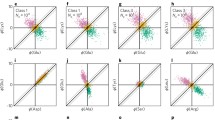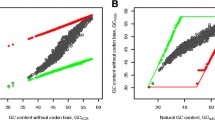Abstract
Understanding how codons became associated with their specific amino acids is fundamental to deriving a theory for the origin of the genetic code. Carl Woese and coworkers designed a series of experiments to test associations between amino acids and nucleobases that may have played a role in establishing the genetic code. Through these experiments it was found that a property of amino acids called the polar requirement (PR) is correlated with the organization of the codon table. No other property of amino acids has been found that correlates with the codon table as well as PR, indicating that PR is uniquely related to the modern genetic code. Using molecular dynamics simulations of amino acids in solutions of water and dimethylpyridine used to experimentally measure PR, we show that variations in the partitioning between the two phases as described by radial distribution functions correlate well with the measured PRs. Partition coefficients based on probability densities of the amino acids in each phase have the linear behavior with base concentration as suggested by PR experiments.








Similar content being viewed by others
References
Alff-Steinberger C (1969) The genetic code and error transmission. Proc Natl Acad Sci USA 64:584–591
Allen M, Tildesley D (1987) Computer simulation of liquids. Clarendon Press, Oxford
Baaske P, Weinert FM, Duhr S, Lemke KH, Russell MJ, Braun D (2007) Extremeaccumulation of nucleotides in simulated hydrothermal pore systems. Proc Natl Acad Sci USA 104:9346–9351
Butler T, Goldenfeld N, Mathew D, Luthey-Schulten Z (2008) Extreme genetic code optimality from a molecular dynamics calculation of amino acid polar requirement. arXiv:0712.3332v2[q-bio.PE]
Campo MG (2006) Molecular dynamics simulation of glycine zwitterion in aqueous solution. J Chem Phys 125:114511
Caporaso JG, Yarus M, Knight R (2005) Error minimization and coding triplet/binding site associations are independent features of the canonical genetic code. J Mol Evol 61:597–607
Cohen J, Arkhipov A, Braun R, Schulten K (2006) Imaging the migration pathways for O2, CO, NO, and Xe inside myoglobin. Biophys J 91:1844–1857
Consden R, Gordon AH, Martin AJP (1944) Qualitative analysis of proteins: a partition chromatographic method using paper. BCHJ 38(3):224–232
Di Giulio M (1989) The extension reached by the minimization of the polarity distances during the evolution of the genetic code. J Mol Evol 29:288–293
England A, Cohn EJ (1935) Studies in the physical chemistry of amino acids, peptides and related substances in the distribution coefficients of amino acids between water and butyl alcohol. J Am Chem Soc 57:634–637
Ferris J, Joshi P, Wang K-J, Miyakawa S, Huang W (2004) Catalysis in prebiotic chemistry: application to the synthesis of RNA oligomers. Adv Space Res 33:100–105
Freeland SJ, Hurst LD (1998) The genetic code is one in a million. J Mol Evol 47(3):238–248
Freeland SJ, Knight RD, Landwebber LF, Hurst LD (2000) Early fixation of an optimal genetic code. Mol Biol Evol 17(4):511–518
Haig D, Hurst LD (1991) A quantitative measure of error minimization in the genetic code. J Mol Evol 33:412–417
Huang W, Ferris JP (2003) Synthesis of 35–40 mers of RNA oligomers from unblocked monomers. A simple approach to the RNA world. Chem Commun 12:1458–1459
Humphrey W, Dalke A, Schulten K (1996) VMD—visual molecular dynamics. J Mol Graph 14:33–38
Knight RD (2001) The origin and evolution of the genetic code: statistical and experimental investigations. PhD thesis, Princeton University
MacKerell AD Jr, Banavali N (2000) All-atom empirical force field for nucleic acids: 2. Application to molecular dynamics simulations of DNA and RNA in solution. J Comp Chem 21:105–120
MacKerell AD Jr, Bashford D, Bellott M, Dunbrack R Jr, Evanseck J, Field M, Fischer S, Gao J, Guo H, Ha S, Joseph-McCarthy D, Kuchnir L, Kuczera K, Lau F, Mattos C, Michnick S, Ngo T, Nguyen D, Prodhom B, Reiher W III, Roux B, Schlenkrich M, Smith J, Stote R, Straub J, Watanabe M, Wiorkiewicz-Kuczera J, Yin D, Karplus M (1998) All-atom empirical potential for molecular modeling and dynamics studies of proteins. J Phys Chem B 102:3586–3616
Martin AJP, Synge RLM (1941) A new form of chromatogram employing two liquid phases. 1. A theory of chromatography. 2. Application to the micro-determination of the higher monoamino-acids in proteins. Biochem J 35:1358–1368
McQuarrie DA (2000) Statistical mechanics, 2nd edn. University Science Books, Sausalito, CA
Miller JC, Rallison JM (2007) Interfacial instability between sheared elastic liquids in a channel. J Non-Newton Fluid Mech 143:71–78
Mirzaev SZ, Behrends R, Heimburg T, Haller J, Kaatze U (2006a) Critical behavior of 2,6-dimethylpyridine-water: measurements of specific heat, dynamic light scattering, and shear viscosity. J Chem Phys 124:144517
Mirzaev SZ, Iwanowski I, Zaitdinov M, Kaatze U (2006b) Critical dynamics and kinetics of elementary reactions of 2,6-dimethylpyridine-water. Chem Phys Lett 431:308–312
Nigmatullin R, Lovitt R, Wright C, Linder M, Nakari-Setälä T, Gama M (2004) Atomic force microscopy study of cellulose surface interaction controlled by cellulose binding domains. Colloids Surf B Biointerfaces 35:125–135
Nimlos MR, Matthews JF, Crowley MF, Walker RC, Chukkapalli G, Brady JW, Adney WS, Cleary JM, Zhong L, Himmel ME (2007) Molecular modeling suggests induced fit of Family I carbohydrate-binding modules with a broken-chain cellulose surface. Protein Eng Des Sel 20:1–9
Phillips JC, Braun R, Wang W, Gumbart J, Tajkhorshid E, Villa E, Chipot C, Skeel RD, Kale L, Schulten K (2005) Scalable molecular dynamics with NAMD. J Comp Chem 26:1781–1802
Sotomayor M, Vásquez V, Perozo E, Schulten K (2007) Ion conduction through MscS as determined by electrophysiology and simulation. Biophys J 92:886–902
Woese CR (1973) Evolution of the genetic code. Naturwissenschaften 60(10):447–459
Woese CR, Dugre DH, Dugre SA, Kondo M, Saxinger WC (1966a) On the fundamental nature and evolution of the genetic code. Cold Spring Harb Symp Quant Biol 31:723–736
Woese CR, Dugre DH, Saxinger WC, Dugre SA (1966b) The molecular basis for the genetic code. Proc Natl Acad Sci USA 55(4):966–974
Woese CR, Olsen GJ, Ibba M, Söoll D (2000) Aminoacyl-tRNA synthetases, the genetic code, and the evolutionary process. Microbiol Mol Biol Rev 64:202–236
Yarus M, Caporaso JG, Knight R (2005) Origins of the genetic code: the escaped triplet theory. Annu Rev Biochem 74:179–198
Acknowledgments
This work was funded by NSF-FIBR Grant SBCSF0526747. Some simulations were performed at the National Center for Supercomputing Applications through Teragrid LRAC No. MCA03S027S and through the University of Illinois School of Chemical Sciences computational resource NSF CRIF 05-41659. We wish to thank Carl Woese, Patrick O’Donoghue, and members of the Luthey-Schulten group for helpful discussions. Jordi Cohen provided analysis software for the occupancy probability studies, and Elijah Roberts assisted in parallelizing the RDF analysis software. Nigel Goldenfeld and Tom Butler provided helpful discussions on genetic code optimality. NAMD and VMD were developed by the Theoretical and Computational Biophysics Group of the Beckman Institute for Advanced Science and Technology at the University of Illinois at Urbana-Champaign.
Author information
Authors and Affiliations
Corresponding author
Rights and permissions
About this article
Cite this article
Mathew, D.C., Luthey-Schulten, Z. On the Physical Basis of the Amino Acid Polar Requirement. J Mol Evol 66, 519–528 (2008). https://doi.org/10.1007/s00239-008-9073-9
Received:
Revised:
Accepted:
Published:
Issue Date:
DOI: https://doi.org/10.1007/s00239-008-9073-9




